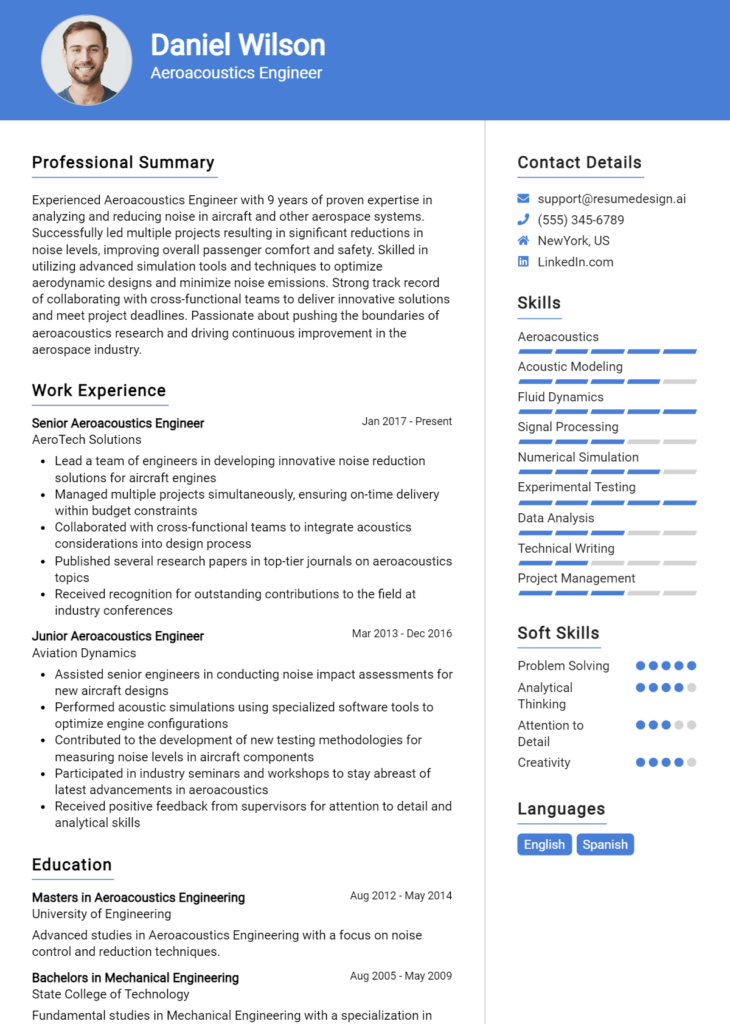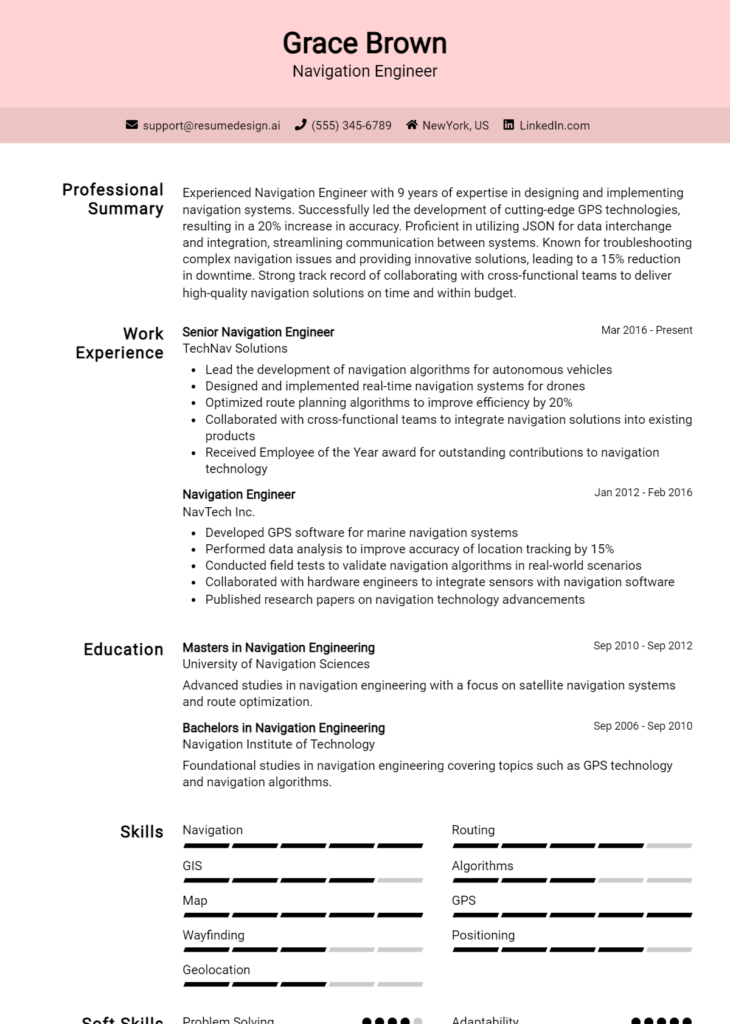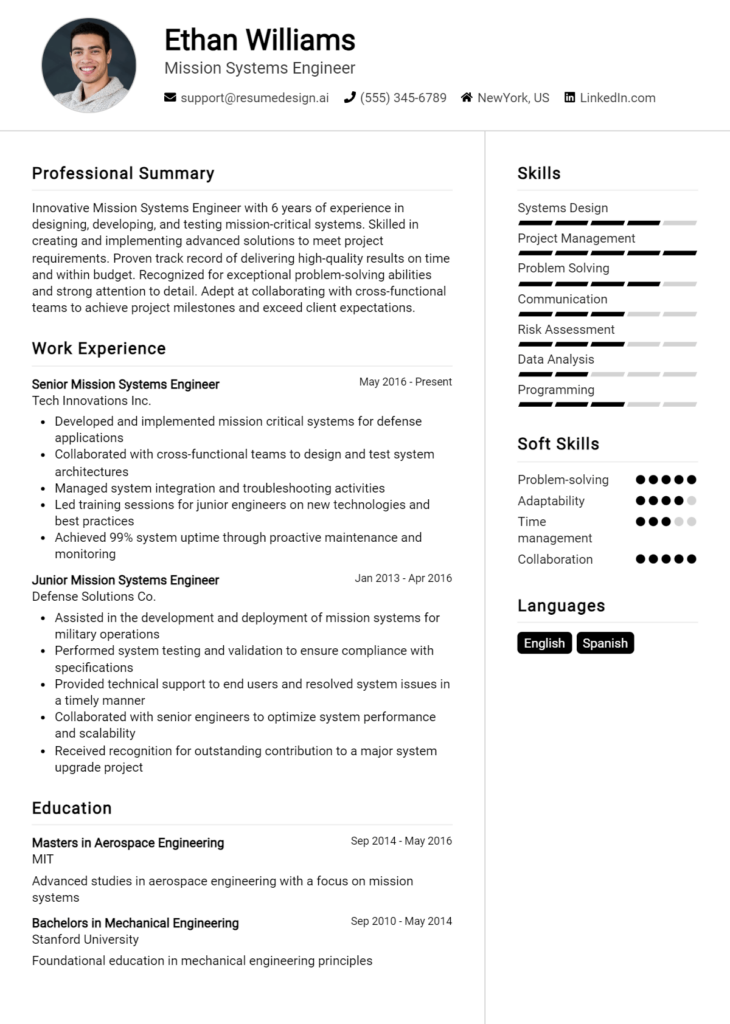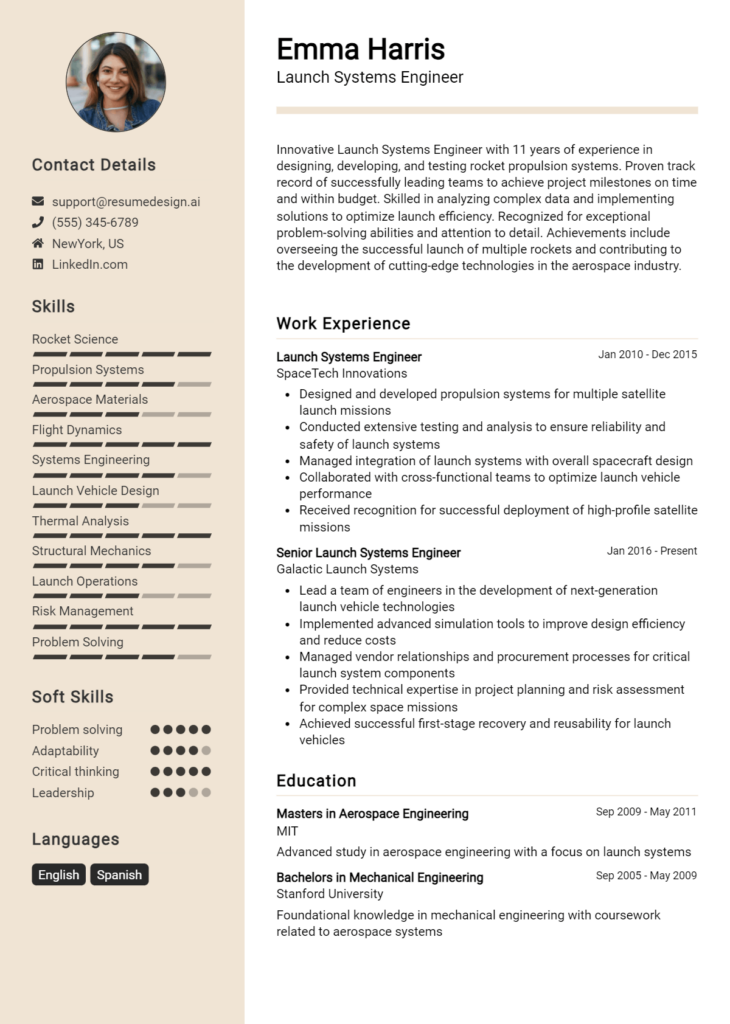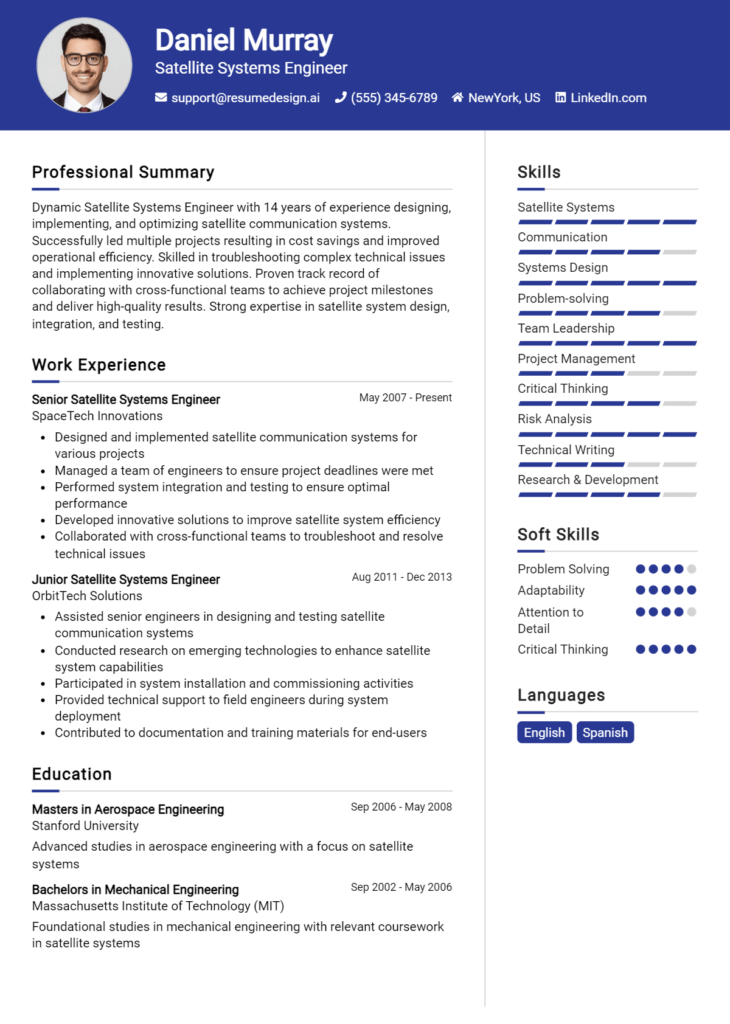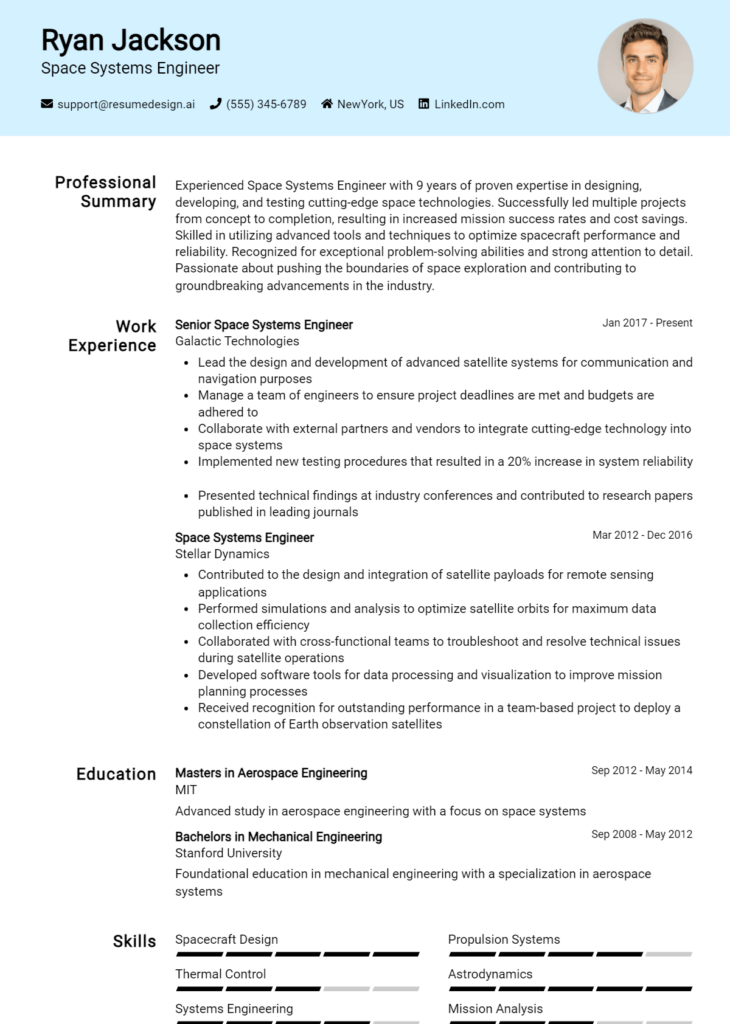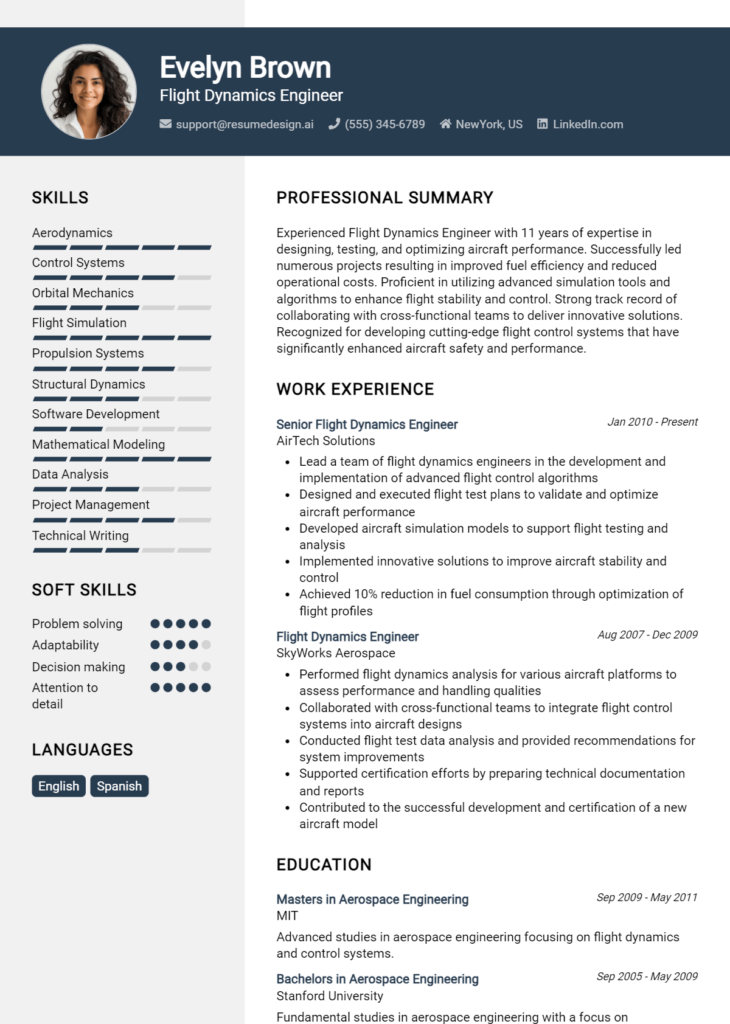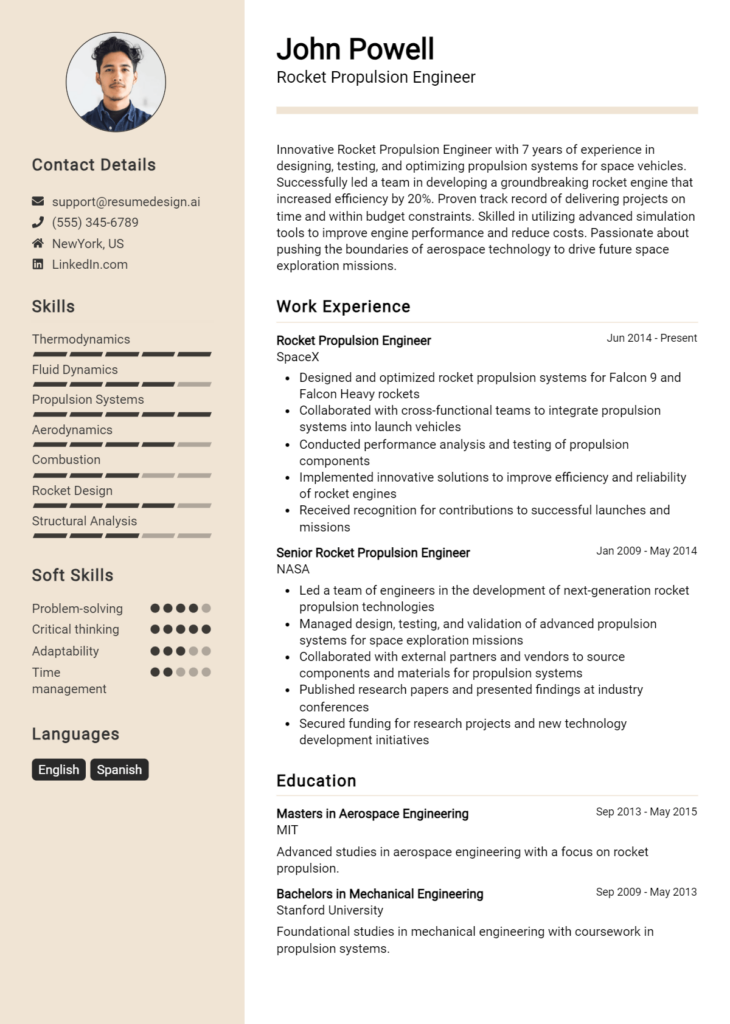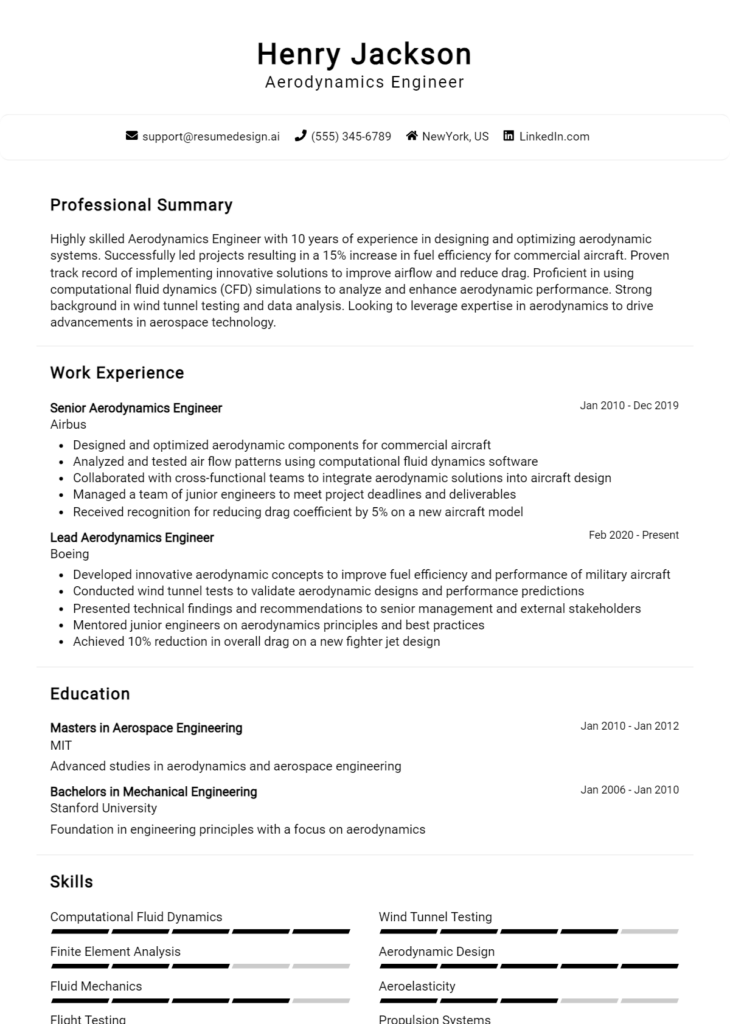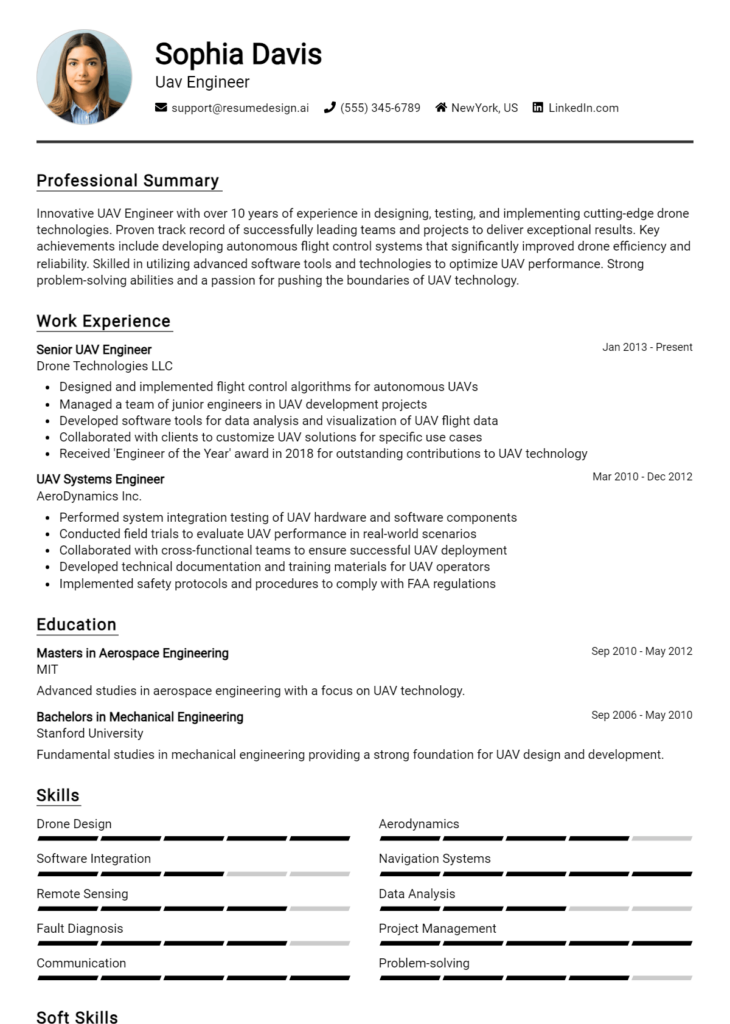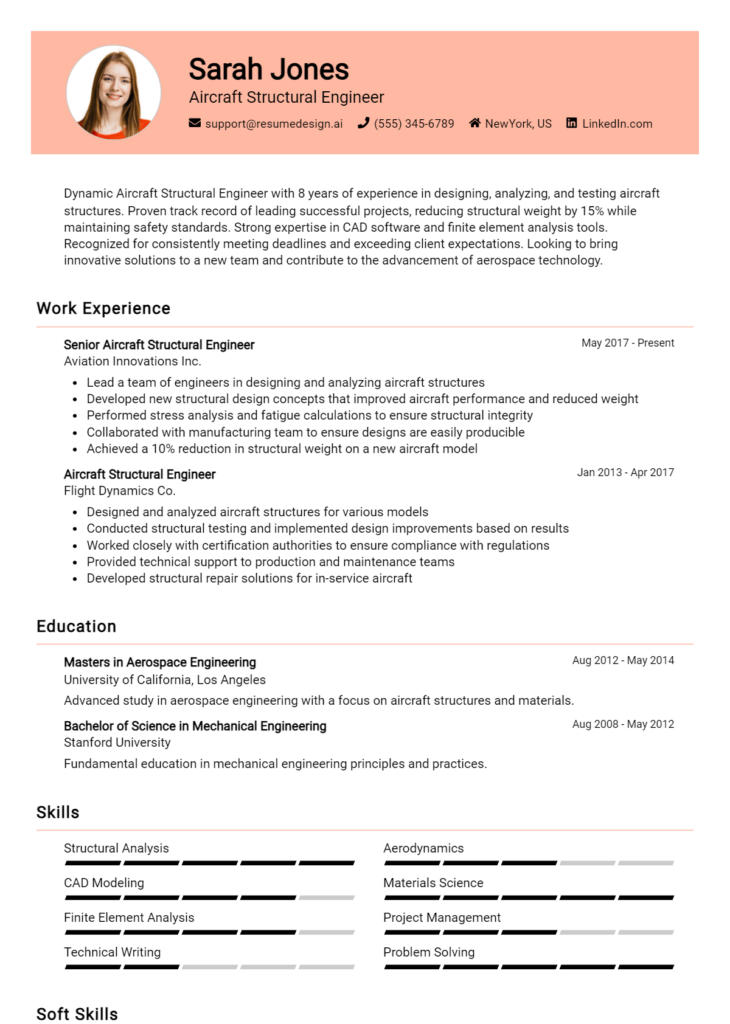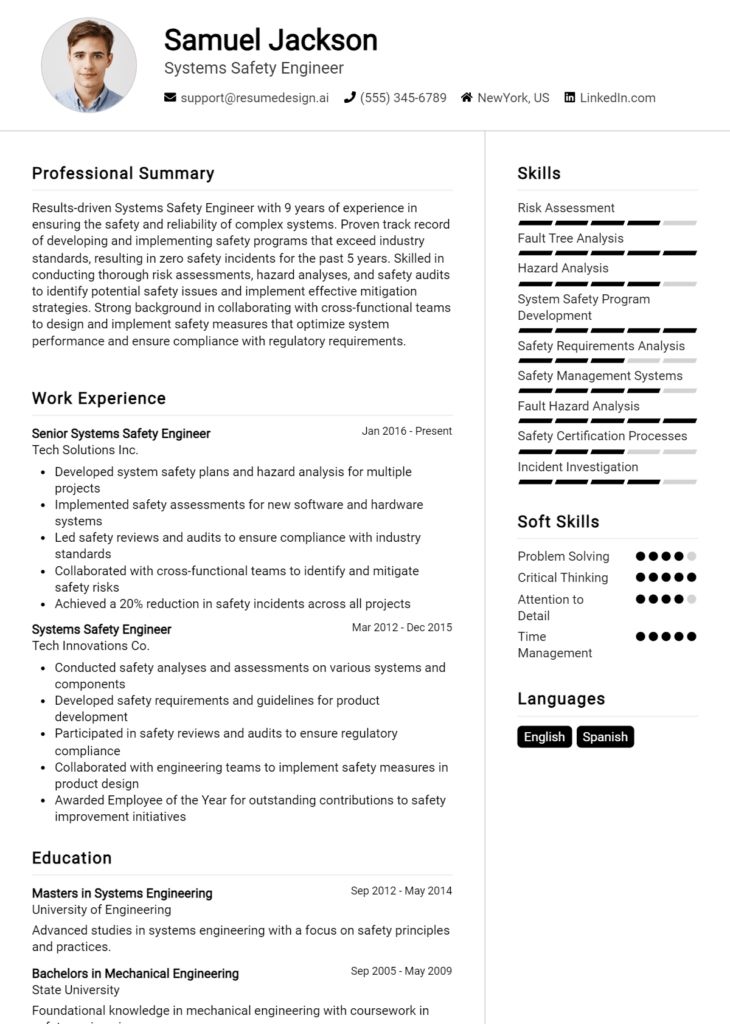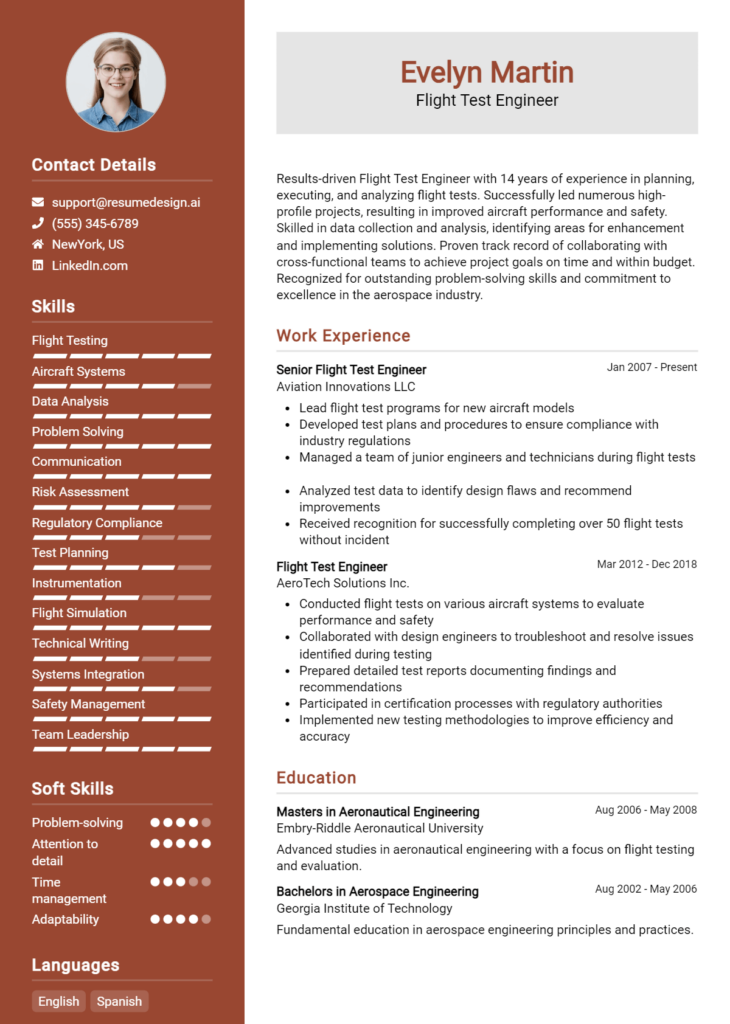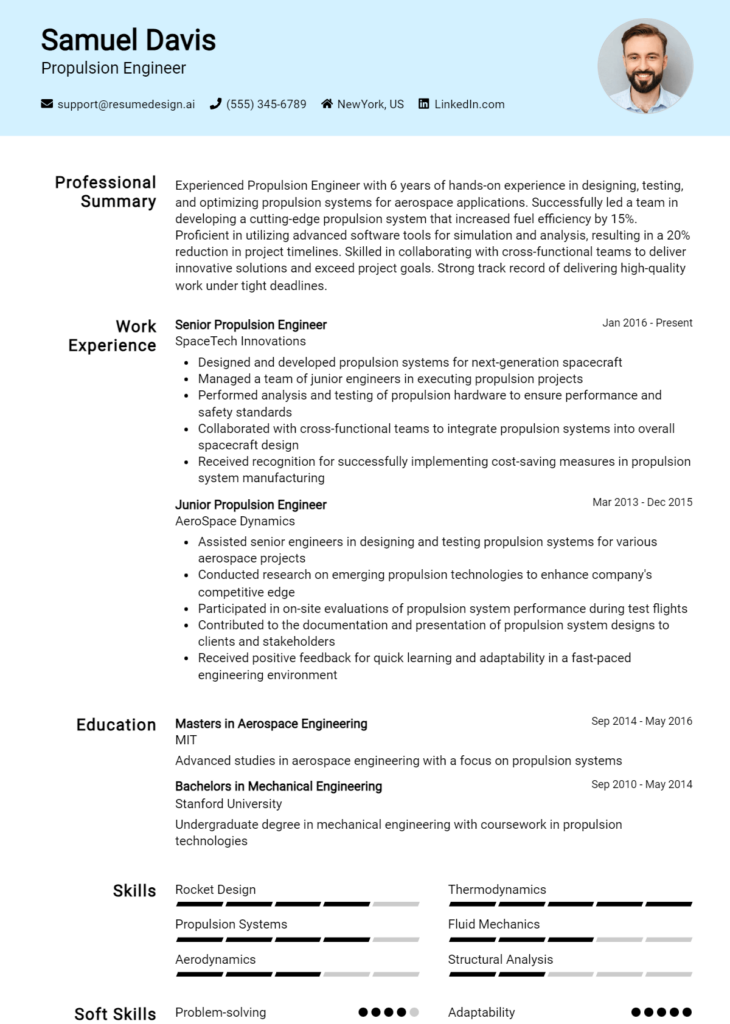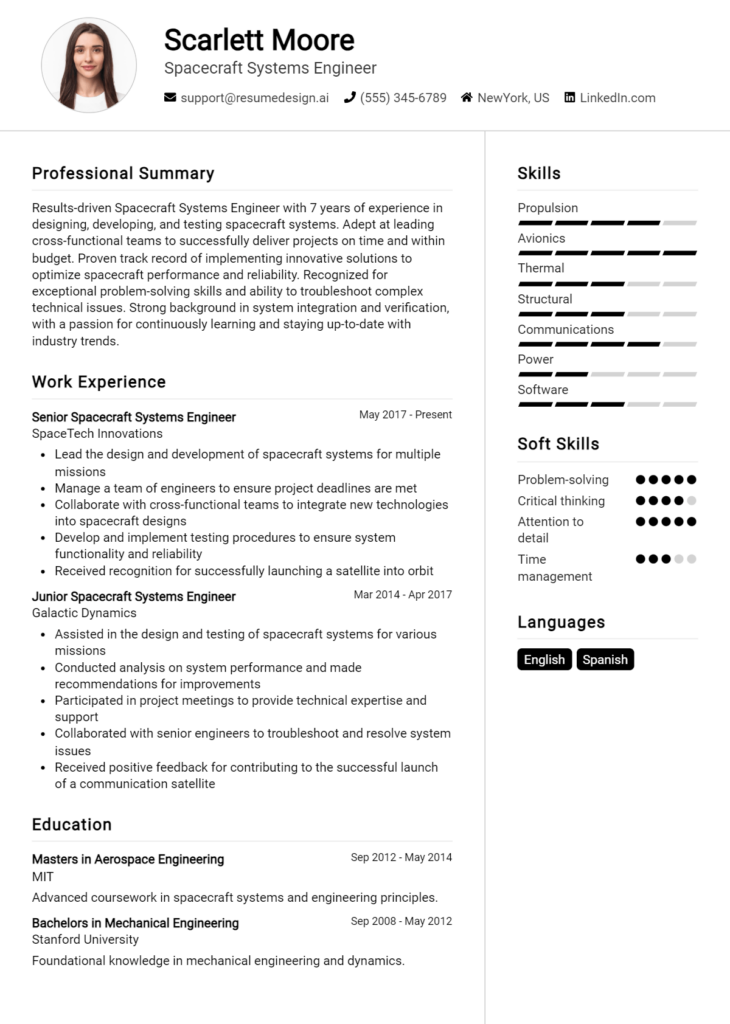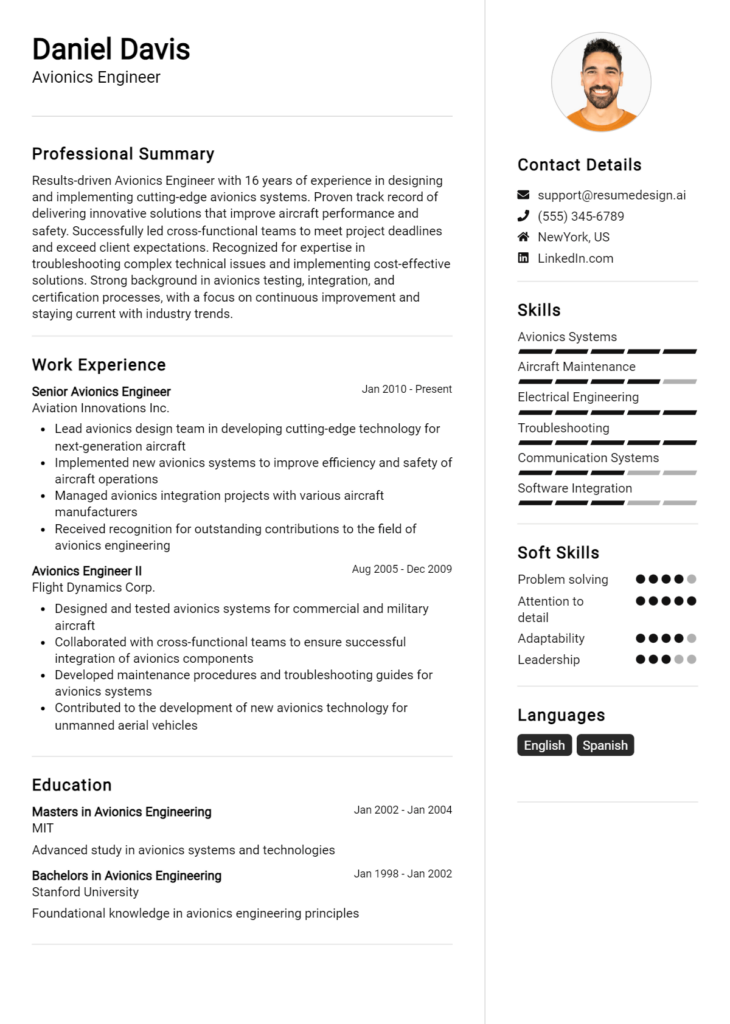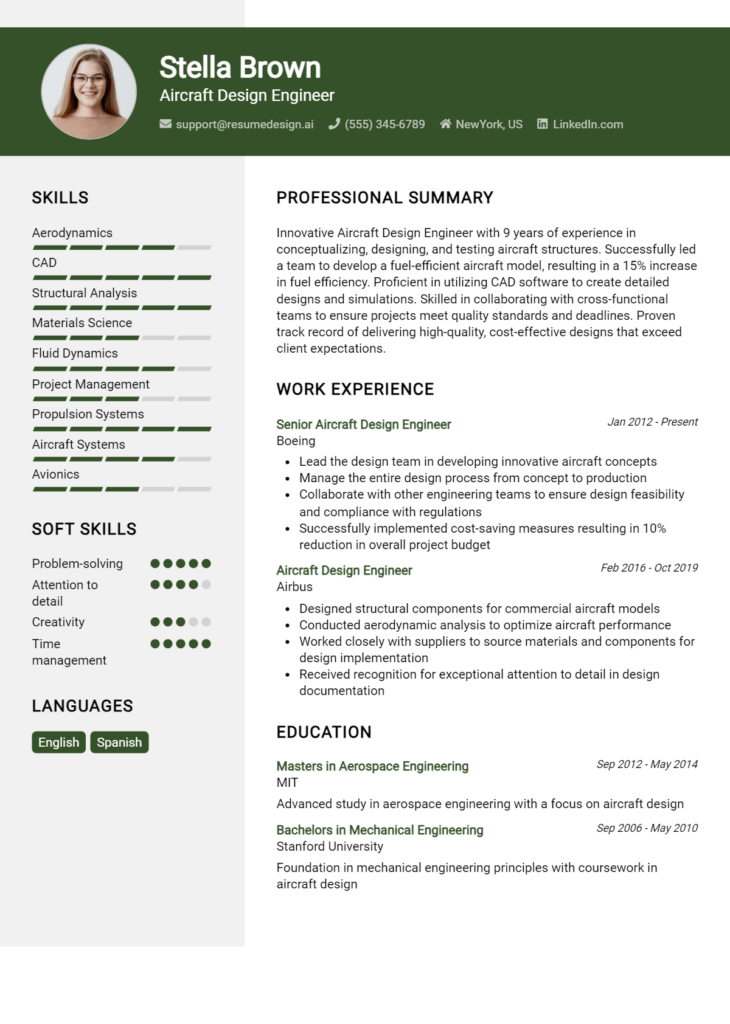Aerospace Materials Engineer Core Responsibilities
An Aerospace Materials Engineer plays a vital role in the design and development of materials used in aviation and space exploration. Key responsibilities include conducting materials testing, developing new materials, and collaborating with design and manufacturing teams to ensure optimal performance and safety. Essential skills encompass technical expertise, operational efficiency, and strong problem-solving abilities. These competencies are crucial for meeting organizational goals, and a well-structured resume can effectively highlight these qualifications, showcasing the candidate's potential impact on the industry.
Common Responsibilities Listed on Aerospace Materials Engineer Resume
- Conducting research to develop advanced aerospace materials.
- Performing materials testing and evaluation for performance and reliability.
- Collaborating with design engineers to select appropriate materials.
- Analyzing failure data and proposing improvements.
- Ensuring compliance with industry standards and regulations.
- Developing and implementing material processing techniques.
- Participating in cross-functional teams for product development.
- Preparing technical reports and documentation.
- Staying updated on emerging materials and technologies.
- Providing technical support and guidance to manufacturing teams.
- Evaluating the lifecycle and sustainability of materials.
- Conducting cost analysis for material selection and usage.
High-Level Resume Tips for Aerospace Materials Engineer Professionals
In the competitive field of aerospace engineering, a well-crafted resume is essential for professionals looking to make their mark as Aerospace Materials Engineers. This document often serves as the first impression a candidate makes on potential employers, making it vital that it effectively reflects their skills, achievements, and expertise. A strong resume not only showcases technical proficiency but also tells a story of career progression and accomplishments in the industry. In this guide, we will offer practical and actionable resume tips specifically tailored for Aerospace Materials Engineer professionals, helping you stand out in a crowded job market.
Top Resume Tips for Aerospace Materials Engineer Professionals
- Tailor your resume to the specific job description, ensuring that you highlight the skills and experience most relevant to the position.
- Begin with a strong summary statement that captures your expertise in aerospace materials and your professional goals.
- Showcase relevant experience by detailing projects that demonstrate your ability to work with different materials and technologies in aerospace applications.
- Quantify your achievements where possible; use metrics to illustrate the impact of your contributions, such as cost savings, efficiency improvements, or successful project completions.
- Highlight industry-specific skills, such as knowledge of composite materials, fatigue analysis, and material selection processes.
- Include any certifications or training relevant to aerospace materials engineering, such as Six Sigma or AS9100 standards.
- Utilize keywords from the job posting throughout your resume to ensure it aligns with applicant tracking systems (ATS).
- Incorporate a section for professional affiliations or memberships in organizations related to aerospace engineering, which can demonstrate your commitment to the field.
- Keep the format clean and professional, ensuring readability and a logical flow of information to engage the reader.
By implementing these tips, Aerospace Materials Engineer professionals can significantly enhance their resumes, increasing their chances of landing that coveted job in the aerospace industry. A focused and polished resume will not only attract the attention of potential employers but also position candidates as strong contenders in a highly specialized field.
Why Resume Headlines & Titles are Important for Aerospace Materials Engineer
Resume headlines and titles are crucial elements for an Aerospace Materials Engineer's resume, as they serve as the first impression for hiring managers. A well-crafted headline can immediately grab attention and succinctly summarize a candidate's key qualifications in one impactful phrase. This is particularly important in a competitive field like aerospace engineering, where hiring managers often sift through numerous applications. A strong headline should be concise, relevant, and directly related to the specific job being applied for, ensuring that it resonates with the employer's needs and expectations.
Best Practices for Crafting Resume Headlines for Aerospace Materials Engineer
- Keep it concise: Aim for one impactful sentence that summarizes your qualifications.
- Be role-specific: Tailor your headline to reflect the specific requirements of the aerospace materials engineering position.
- Highlight key skills: Include core competencies or specialized skills relevant to the aerospace field.
- Showcase accomplishments: If possible, incorporate measurable achievements to stand out.
- Use industry terminology: Utilize terms and jargon common in aerospace engineering to demonstrate expertise.
- Avoid generic phrases: Steer clear of vague titles that don't convey specific value or expertise.
- Focus on relevance: Ensure that every word in the headline directly relates to the job description.
- Edit and refine: Regularly revise your headline to reflect your most current experiences and skills.
Example Resume Headlines for Aerospace Materials Engineer
Strong Resume Headlines
Innovative Aerospace Materials Engineer with 10+ Years of Experience in Composite Materials Development
Expert in Lightweight Alloys and Advanced Manufacturing Techniques for Aerospace Applications
Results-Driven Aerospace Engineer Specializing in High-Performance Material Solutions
Skilled Aerospace Materials Engineer Focused on Sustainable Materials and Environmental Compliance
Weak Resume Headlines
Engineer Looking for Job
Aerospace Professional
Materials Engineer with Some Experience
The strong headlines are effective because they clearly articulate specific skills, experiences, and achievements that align with the role of an Aerospace Materials Engineer. They immediately convey value, making it easy for hiring managers to see the candidate's fit for the position. In contrast, the weak headlines fail to impress due to their vagueness and lack of specificity, providing no compelling reason for an employer to consider the candidate further. A strong headline acts as a powerful marketing tool, while a weak one leaves the candidate overlooked in a pool of applications.
Writing an Exceptional Aerospace Materials Engineer Resume Summary
A resume summary is a crucial component of an Aerospace Materials Engineer's application as it serves as the first impression for hiring managers. A well-crafted summary quickly captures attention by succinctly showcasing key skills, relevant experience, and significant accomplishments that align with the job role. It acts as a personal branding statement that highlights the candidate's unique qualifications and sets the tone for the rest of the resume. A concise and impactful summary, tailored to the specific job description, can significantly enhance a candidate's chances of standing out in a competitive field.
Best Practices for Writing a Aerospace Materials Engineer Resume Summary
- Quantify achievements: Use numbers to demonstrate the impact of your work, such as project cost savings or performance improvements.
- Focus on relevant skills: Highlight technical and soft skills that are specific to aerospace materials engineering, such as materials selection and failure analysis.
- Tailor the summary: Customize your summary to reflect the requirements and keywords found in the job description you’re applying for.
- Use action verbs: Start sentences with strong action verbs to convey a sense of proactivity and initiative.
- Keep it concise: Aim for 2-4 sentences that deliver maximum impact without overwhelming the reader.
- Showcase industry knowledge: Mention familiarity with relevant aerospace standards, regulations, and innovative materials.
- Highlight teamwork and collaboration: Emphasize experience working in cross-functional teams or leading projects to showcase your collaborative skills.
- Demonstrate continuous learning: Mention any relevant certifications or training that demonstrate your commitment to professional development in aerospace materials.
Example Aerospace Materials Engineer Resume Summaries
Strong Resume Summaries
Results-driven Aerospace Materials Engineer with over 7 years of experience in developing lightweight composite materials for aircraft structures, leading to a 20% reduction in fuel consumption in recent projects.
Detail-oriented engineer skilled in material characterization and failure analysis, successfully improving product durability by 30% through innovative testing methodologies and material selection strategies.
Dedicated Aerospace Materials Engineer with a proven track record of managing cross-functional teams on projects that enhanced material performance, achieving a 15% increase in overall project efficiency.
Weak Resume Summaries
Aerospace Engineer with experience in materials and some knowledge of engineering principles.
Motivated individual seeking to leverage skills in aerospace materials engineering to contribute to company success.
The strong resume summaries are effective because they clearly articulate specific achievements, quantify results, and highlight relevant skills that align with the aerospace materials engineering role. They demonstrate a clear understanding of the field and the impact the candidate has made in previous positions. In contrast, the weak summaries lack specificity, fail to provide measurable outcomes, and come across as generic, making it difficult for hiring managers to grasp the candidate's true potential and fit for the role.
Work Experience Section for Aerospace Materials Engineer Resume
The work experience section of an Aerospace Materials Engineer resume is crucial as it serves as a comprehensive showcase of the candidate's technical skills, leadership capabilities, and track record of delivering high-quality products. This section not only highlights the candidate's relevant experience but also demonstrates their ability to manage teams effectively and achieve quantifiable results. By aligning their experience with industry standards and providing metrics that illustrate their accomplishments, candidates can significantly enhance their appeal to potential employers in the highly competitive aerospace sector.
Best Practices for Aerospace Materials Engineer Work Experience
- Use specific technical jargon relevant to aerospace materials engineering to demonstrate expertise.
- Quantify achievements with measurable outcomes, such as percentage improvements or cost savings.
- Highlight experience in managing cross-functional teams and leading projects to successful completion.
- Focus on results-oriented statements that reflect your contributions to major projects.
- Align your work experience with industry standards and technologies currently in use.
- Incorporate keywords from job descriptions to enhance visibility to applicant tracking systems.
- Utilize action verbs to convey a sense of proactivity and impact in your roles.
- Provide context for your achievements, explaining the challenges faced and how you overcame them.
Example Work Experiences for Aerospace Materials Engineer
Strong Experiences
- Led a team of 10 engineers in the development of a new lightweight composite material, resulting in a 15% reduction in aircraft weight and a projected cost savings of $1 million annually.
- Implemented a materials testing protocol that improved failure detection rates by 30%, significantly enhancing product reliability in aerospace applications.
- Collaborated with cross-functional teams to design and certify a new alloy for use in high-stress environments, achieving FAA certification six months ahead of schedule.
Weak Experiences
- Worked on various projects related to materials engineering.
- Assisted in testing materials in the lab.
- Participated in team meetings to discuss aerospace materials.
The examples provided illustrate the difference between strong and weak experiences in an Aerospace Materials Engineer resume. Strong experiences are characterized by specific, quantifiable outcomes that demonstrate not only technical expertise but also effective leadership and collaboration. They provide clear evidence of contributions to significant projects and improvements. In contrast, weak experiences lack detail and measurable results, making it difficult for potential employers to assess the candidate's capabilities and impact in the field.
Education and Certifications Section for Aerospace Materials Engineer Resume
The education and certifications section of an Aerospace Materials Engineer resume is crucial as it showcases the candidate's academic background and industry-relevant qualifications. This section not only highlights degrees that are pertinent to the field but also emphasizes certifications and specialized training that reflect the candidate's commitment to continuous learning and professional development. By providing relevant coursework and certifications, candidates can enhance their credibility and demonstrate their alignment with the specific requirements of the aerospace industry, effectively positioning themselves as strong contenders for the role.
Best Practices for Aerospace Materials Engineer Education and Certifications
- Include degrees that are directly relevant to aerospace engineering, materials science, or related fields.
- List any certifications that are recognized in the aerospace industry, such as Six Sigma or AS9100.
- Detail relevant coursework that demonstrates an understanding of materials properties, testing, and applications in aerospace.
- Highlight any specialized training or workshops attended that pertain to aerospace materials.
- Use clear and concise language to describe educational experiences and certifications.
- Prioritize recent and relevant qualifications to show ongoing professional development.
- Consider including GPA or honors if they are impressive and relevant.
- Format the section for easy readability, using bullet points for clarity.
Example Education and Certifications for Aerospace Materials Engineer
Strong Examples
- M.S. in Aerospace Engineering, University of Michigan, 2022
- Certified Materials Engineer (CME), National Institute for Certification in Engineering Technologies, 2023
- B.S. in Materials Science and Engineering, Georgia Institute of Technology, 2020
- Relevant Coursework: Advanced Composite Materials, Metal Alloys for Aerospace Applications, and Polymer Science.
Weak Examples
- B.A. in English Literature, Harvard University, 2018
- Certification in Basic Welding Techniques, 2015
- High School Diploma, Lincoln High School, 2016
- Unrelated Coursework: Introduction to Psychology, Art History.
The strong examples are considered effective because they directly align with the qualifications necessary for an Aerospace Materials Engineer, showcasing relevant degrees, certifications, and coursework that speak to the candidate's expertise in the field. In contrast, the weak examples fail to demonstrate pertinent knowledge or skills related to aerospace materials, highlighting degrees and certifications that are outdated or unrelated, which detracts from the candidate's suitability for the role.
Top Skills & Keywords for Aerospace Materials Engineer Resume
As an Aerospace Materials Engineer, showcasing a well-rounded skill set on your resume is crucial for standing out in a competitive job market. The aerospace industry demands not only technical expertise but also a range of soft skills that facilitate collaboration, problem-solving, and innovation. Highlighting these skills effectively can demonstrate your ability to contribute to complex projects, work within multidisciplinary teams, and adapt to the dynamic challenges of aerospace engineering. A strong resume will balance both hard and soft skills, providing potential employers with a comprehensive view of your capabilities and making you a more attractive candidate in the field.
Top Hard & Soft Skills for Aerospace Materials Engineer
Soft Skills
- Strong communication skills
- Team collaboration
- Problem-solving abilities
- Attention to detail
- Critical thinking
- Time management
- Adaptability
- Leadership qualities
- Creativity
- Conflict resolution
Hard Skills
- Materials selection and testing
- Knowledge of composite materials
- Proficiency in CAD software
- Familiarity with aerospace regulations and standards
- Finite element analysis (FEA)
- Materials characterization techniques
- Thermodynamics and material properties
- Manufacturing processes and techniques
- Project management
- Data analysis and statistical methods
For a deeper understanding of how to effectively incorporate these skills into your resume and highlight your relevant work experience, consider tailoring your application to reflect both the technical and interpersonal competencies that employers in the aerospace sector value most.
Stand Out with a Winning Aerospace Materials Engineer Cover Letter
I am writing to express my strong interest in the Aerospace Materials Engineer position at [Company Name], as advertised on [Job Board/Company Website]. With a Master’s degree in Materials Science and over five years of experience in the aerospace sector, I have developed a robust understanding of materials selection, testing, and processing that directly aligns with the needs of your innovative engineering team. My hands-on experience with advanced composite materials and metal alloys, combined with a passion for sustainable engineering practices, positions me uniquely to contribute to [Company Name]'s commitment to cutting-edge aerospace solutions.
During my tenure at [Previous Company Name], I successfully led a project focused on the development of lightweight composite materials for aircraft structures, which resulted in a 15% reduction in overall weight without compromising structural integrity. My role involved extensive collaboration with multidisciplinary teams, ensuring that our materials met rigorous safety standards while also being cost-effective. Additionally, I have a strong background in failure analysis and materials characterization, allowing me to troubleshoot issues and optimize performance throughout the product lifecycle. I am particularly excited about the opportunity at [Company Name] due to your emphasis on innovation and sustainability in aerospace materials.
I am adept at utilizing advanced simulation tools and conducting rigorous testing protocols to inform materials selection and processing techniques. My ability to communicate complex technical information to stakeholders at all levels has proven essential in driving projects to successful completion. I am eager to bring my analytical skills, creative problem-solving abilities, and a strong commitment to quality to [Company Name], and I am confident that my background and enthusiasm for aerospace engineering would make me a valuable addition to your team.
Thank you for considering my application. I look forward to the opportunity to discuss how my expertise in materials engineering can support [Company Name]'s goals and contribute to groundbreaking aerospace advancements. I am excited about the possibility of being part of a team that is dedicated to pushing the boundaries of technology and innovation in the aerospace industry.
Common Mistakes to Avoid in a Aerospace Materials Engineer Resume
When crafting a resume for an Aerospace Materials Engineer position, it's crucial to present your qualifications and experience effectively. However, many candidates make common mistakes that can hinder their chances of landing an interview. By avoiding these pitfalls, you can create a resume that highlights your skills and aligns with the specific requirements of the aerospace industry. Here are some common mistakes to watch out for:
Generic Objective Statements: Using a vague objective that does not specifically mention the aerospace field can signal a lack of focus. Tailor your objective to reflect your interest in aerospace materials engineering.
Ignoring Keywords: Failing to include industry-specific keywords found in the job description can result in your resume being overlooked by automated applicant tracking systems. Make sure to integrate relevant terms and phrases.
Overloading with Technical Jargon: While it's important to demonstrate your technical expertise, using excessive jargon can make your resume difficult to read. Strive for a balance that showcases your knowledge without alienating non-technical reviewers.
Neglecting Relevant Experience: Omitting internships, projects, or coursework that relate to aerospace materials can weaken your application. Highlight all relevant experiences, even if they were part of your education.
Poor Formatting: A cluttered or inconsistent layout can distract from the content of your resume. Use clear headings, bullet points, and a clean design to enhance readability.
Lack of Quantifiable Achievements: Simply listing job responsibilities without quantifying your accomplishments can make your contributions seem less impactful. Use metrics and specific examples to demonstrate your success in previous roles.
Not Tailoring for Each Application: Sending out a one-size-fits-all resume can be detrimental. Customize your resume for each job application to reflect the skills and experiences that are most relevant to the specific position.
Ignoring Soft Skills: Focusing solely on technical skills and neglecting soft skills such as teamwork, communication, and problem-solving can be a mistake. Aerospace projects often require collaboration, so emphasize your interpersonal abilities alongside technical expertise.
Conclusion
As an Aerospace Materials Engineer, your role is pivotal in advancing the aerospace industry through the development and application of materials that withstand extreme conditions while maintaining lightweight properties. Key responsibilities typically include conducting materials research, testing and evaluating performance, collaborating with design teams, and ensuring compliance with safety and regulatory standards.
In this competitive field, having a well-crafted resume is essential to highlight your specialized skills, education, and experience. It's important to tailor your resume to showcase your expertise in material selection, failure analysis, and innovative design solutions, as well as any relevant software proficiency or certifications.
To stand out in your job search, consider reviewing and updating your resume to reflect your most recent achievements and projects. If you need assistance, there are numerous resources available to help you create an impactful resume. Explore our resume templates for structured designs, utilize our resume builder for a user-friendly experience, and check out resume examples for inspiration tailored to your field. Additionally, don’t forget to craft a compelling cover letter using our cover letter templates to further enhance your application.
Take the next step in your career by refining your resume today!



